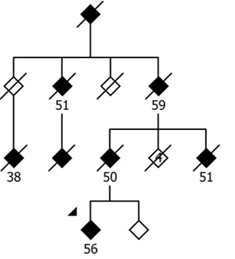Category: Parkinson's Disease: Genetics
Objective: To determine the usefulness of WES in the diagnostic evaluation of Parkinson’s disease (PD) patients and to set up computational pathways for the identification of monogenic PD causes.
Background: PD is the second most common neurodegeneration disorder. Early symptoms include rigidity, tremor and difficulty with balance and coordination. Other symptoms such as depression, anxiety and apathy may also occur. In advanced stages of the disease, dementia is common. The cause seems to be a combination of genetic and environmental factors. Although rare, PD can be monogenic and run in families.
Method: Index cases with PD were included in a research study on genetics especially recruiting patients with familial disease. All patients provided informed written consent. Patients were examined by a neurologist, and relevant data on their disease and on their family history was compiled. Whole exome sequencing was performed and data analyzed for single nucleotide variants (SNVs) and copy number variants (CNVs) were detected by using appropriate in-silico tools. VCF files were annotated with Variant Effect Predictor. Rare variants with MAF <0.01 in gnomAD non-Finnish Europeans and SweFreq and Genotype Quality > 20 were selected. Variants in genes associated with PD (HP:0001300) were assessed further.
Results: Patients’ average age of onset was 58.2 years, 22 of 67 (32.8%) were female and 64 of 67 had a positive family history of PD. No relevant rare CNVs were detected. We identified risk variants in GBA1 in 5 (7.5%) of 67 patients, and two variants in VPS13C in one patient with Parkinsonism with severe bradykinesia, vertical gaze palsy, facial and leg dystonia, dysarthria, nightmares, family analyses are pending (Table). In one family we identified the known VPS35 p.(Asp620Asn) variant that causes autosomal dominant PD; eight family members had PD manifesting at 38-59 (mean 50.8) years, and cognitive decline (Figure).
Conclusion: WES is a suitable method to examine monogenic forms of PD. SNVs and CNVs can be identified by our pipeline. The frequency of GBA1 variants is lower in our population than in international reports. VPS35 p.(Asp620Asn) is a high-penetrance variant causing PD with an age of onset around 50 years and increased risk for dementia, as has been shown previously. Monogenic PD forms remain rare even among familial PD cases, which suggests additional mechanisms underlying familial aggregation of PD.
To cite this abstract in AMA style:
E. Kafantari, A. Puschmann. Whole exome sequencing of 67 Swedish Parkinson patients identifies a family with VPS35 D620N [abstract]. Mov Disord. 2023; 38 (suppl 1). https://www.mdsabstracts.org/abstract/whole-exome-sequencing-of-67-swedish-parkinson-patients-identifies-a-family-with-vps35-d620n/. Accessed December 20, 2025.« Back to 2023 International Congress
MDS Abstracts - https://www.mdsabstracts.org/abstract/whole-exome-sequencing-of-67-swedish-parkinson-patients-identifies-a-family-with-vps35-d620n/

